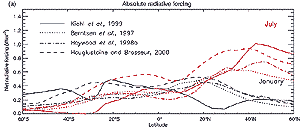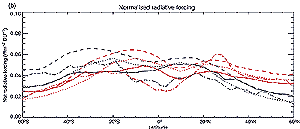Table 6.3 presents a comparison of estimates of globally averaged O3 change since pre-industrial times and its corresponding radiative forcing based on published literature and including stratospheric temperature adjustment. Results from several studies are presented, one constrained by the climatology derived from observations discussed in the previous section, and ten from global chemistry/transport models. Results are presented for both clear sky and for total sky conditions, providing an indication of the role of clouds, and long-wave and short-wave contributions are shown separately. In addition, the globally averaged integrated tropospheric O3 change (DU) is also indicated, to give a sense of the range in published model estimates of this key factor. Finally, the normalised O3 forcings are also presented (Wm-2 per DU).
| Table 6.3: Tropospheric O3 change ( |
||||||||||
|
Clear sky conditions
|
Total sky conditions
|
|||||||||
| Reference |
|
LW
|
SW
|
SW (norm.)
|
Net
|
Net (norm.)
|
LW
|
SW
|
Net
|
Net (norm.)
|
| Berntsen et al. (1997) [Reading model] |
7.600
|
0.260
|
0.050
|
0.007
|
0.310
|
0.041
|
0.210
|
0.070
|
0.280
|
0.037
|
| Stevenson et al. (1998) |
8.700
|
0.326
|
0.065
|
0.007
|
0.391
|
0.045
|
0.201
|
0.088
|
0.289
|
0.033
|
| Berntsen et al. (1997) [Oslo model] |
7.600
|
0.330
|
0.060
|
0.008
|
0.390
|
0.051
|
0.230
|
0.080
|
0.310
|
0.041
|
| Haywood et al. (1998a) |
7.900
|
0.330
|
0.050
|
0.006
|
0.380
|
0.048
|
0.230
|
0.080
|
0.310
|
0.039
|
| Kiehl et al. (1999) |
8.400
|
0.316
|
0.063
|
0.008
|
0.379
|
0.045
|
0.251
|
0.069
|
0.320
|
0.038
|
| Berntsen et al. (2000) |
9.600
|
0.357
|
0.071
|
0.007
|
0.428
|
0.045
|
0.246
|
0.096
|
0.342
|
0.036
|
| Brasseur et al. (1998) |
|
|
|
|
|
|
|
|
0.370
|
|
| van Dorland et al. (1997) |
8.070
|
0.390
|
0.054
|
0.007
|
0.443
|
0.055
|
0.304
|
0.076
|
0.380
|
0.047
|
| Roelofs et al. (1997) |
7.200
|
0.350
|
0.047
|
0.007
|
0.397
|
0.055
|
0.287
|
0.117
|
0.404
|
0.056
|
| Lelieveld and Dentener (2000) |
|
|
|
|
|
|
|
|
0.420
|
|
| Hauglustaine et al. (1998) |
8.940
|
0.448
|
0.063
|
0.007
|
0.511
|
0.057
|
0.338
|
0.088
|
0.426
|
0.048
|
| Mean |
8.224
|
0.345
|
0.058
|
0.007
|
0.403
|
0.049
|
0.255
|
0.085
|
0.343
|
0.042
|
 
Figure 6.2: Latitudinal distribution of absolute (Wm-2) and normalised (Wm-2 DU-1) tropospheric O3 radiative forcing for summer and winter conditions calculated by several models. |
Table 6.3 summarises the ranges obtained in these model studies. For total sky conditions, the range in globally and annual averaged tropospheric O3 forcing from all of these models is from 0.28 to 0.43 Wm-2, while the normalised forcing is 0.033 to 0.056 Wm-2 per DU. The tropospheric O3 forcing constrained by the observational climatology is 0.32 Wm-2 for globally averaged, total sky conditions. These estimates are comparable in magnitude (and qualitatively similar in pattern, see Section 6.14) but opposite in sign to that believed to be due to the direct effect of sulphate aerosols.
Figure 6.2 presents the latitudinal distributions of absolute and normalised forcings for both January and July, from several chemistry/transport models and from the observationally constrained evaluation. The figure shows that the tropics and northern mid-latitude regions account for the bulk of the global forcing. The contribution from northern mid-latitudes is particularly large in summer, when it can reach as much as 1 Wm-2 locally near 40 to 50°N. These latitudinal gradients and seasonal changes in the zonally-averaged forcing are likely to be reflected at least in part in patterns of response (Hansen et al., l997a) and hence are a needed element in the detection and attribution of climate change.
Figure 6.2 shows that the large seasonal and inter-model ranges in absolute forcings compress somewhat when normalised forcings are considered. At 40°N for example, the absolute forcing differs over all models and seasons by more than a factor of 5 (Figure 6.2a), while the differences in normalised forcings are about a factor of 2.5 (Figure 6.2b). Mickley et al. (1999) demonstrate that the normalised forcing at extra-tropical latitudes is largely determined by the temperature difference between the tropopause and the Earths surface, while cloud cover plays a dominant role in the tropics. This suggests that the differences in physical climatology between models, and their comparison to the real atmosphere, may be a key factor in improving understanding of the normalised forcing. The difference between the normalised tropical and mid-latitude forcings also emphasises the need to quantify both the O3 produced by biomass burning (and other tropical processes), and that produced by industrial practices, especially in the northern hemisphere. Some of the studies in Figure 6.2 suggest, for example, that a model producing larger O3 changes in the tropics could produce a greater globally averaged tropospheric O3 forcing than one producing larger changes in northern mid-latitudes, even if the globally averaged O3 increases in the two studies were identical. Overall, this Figure suggests that the differences between model estimates of tropospheric O3 forcing since pre-industrial times are likely to be dominated by chemistry (e.g., emission inventories, chemical processes, and transport) rather than by factors relating to radiative transfer.
|
Other reports in this collection |